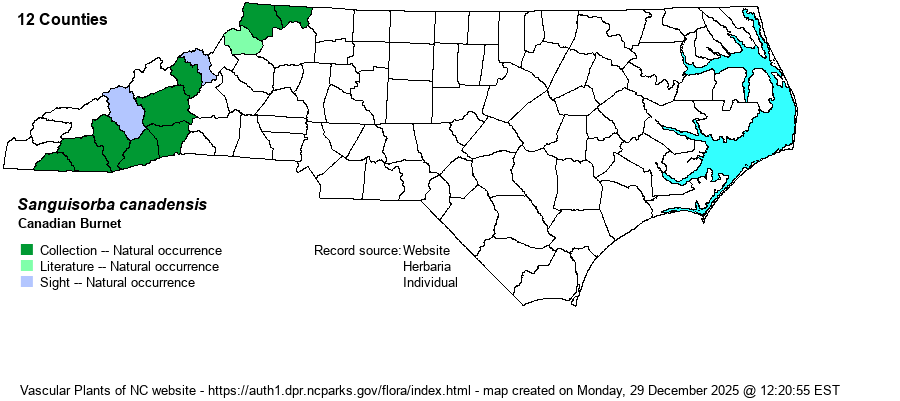| Author | L. | |
| Distribution | Nearly throughout the Mountains, but probably absent in a few extreme southwestern counties. Does not occur in the adjacent Piedmont.
This is a Northern species, found in parts of Canada, and south to NJ, PA, and IL, and sparingly down the Appalachians to northeastern GA.
| |
| Abundance | Rare to locally uncommon. This species formerly was tracked as Significantly Rare by NCNHP, and then moved down to Watch List. However, there are now enough records and sightings that the species is not even now on the Watch List, despite it being very rare in the VA mountains. | |
| Habitat | This is a requisite wetland species, generally in full to partial sun. It grows in bogs, fens, wet meadows, seepages, spray cliffs, and other similar places. Though it has an affinity for high pH soils, it is widespread enough in NC that some sites are certainly in acidic soil situations. |
| Phenology | Blooms from late July into September, and fruits in September and October. | |
| Identification | This is a robust, tall (3-5 feet), and rather elegant species, like no other native species in NC. It has scattered alternate leaves that are very large and divided into many pinnate leaflets. Each leaf can be 1 foot or more long, and the 4-5 pairs of leaflets, with a terminal one, are each about 2 inches long and 3/4-inch wide, oblong and quite squared-off at the base, with a rounded tip. The margins are finely serrated as well. There are usually a few short branches near the stem top, and each is topped by a very dense spike of flowers, about 4-5 inches long but narrow. There are no petals, but the sepals are white as are the stamens. It is the stamens that give the spike its white color, and thus it looks quite fuzzy up close. In fact, it could be passed over as a flowering grass by some biologists, at least at a distance, until the odd leaves are seen. You might be able to see this spectacular species from your car where you pass by wetlands, such as seepages at the bases of rock cuts or cliffs, and not have to trample around in privately-owned bogs and wet meadows. | |
| Taxonomic Comments | None
| |
| Other Common Name(s) | American Burnet, White Burnet, Canada Burnet | |
| State Rank | S3 | |
| Global Rank | G5 | |
| State Status | | |
| US Status | | |
| USACE-agcp | FACW link |
| USACE-emp | FACW link |

